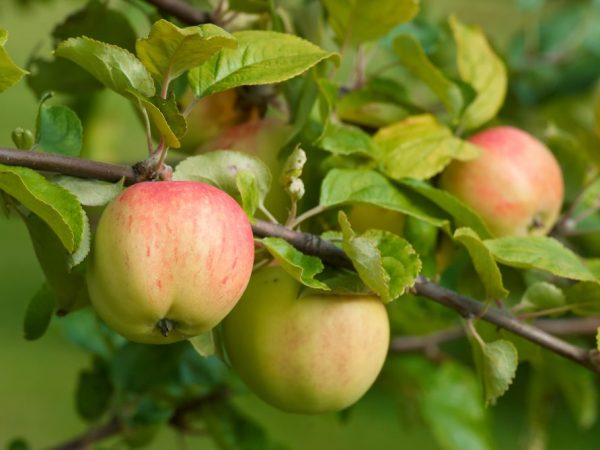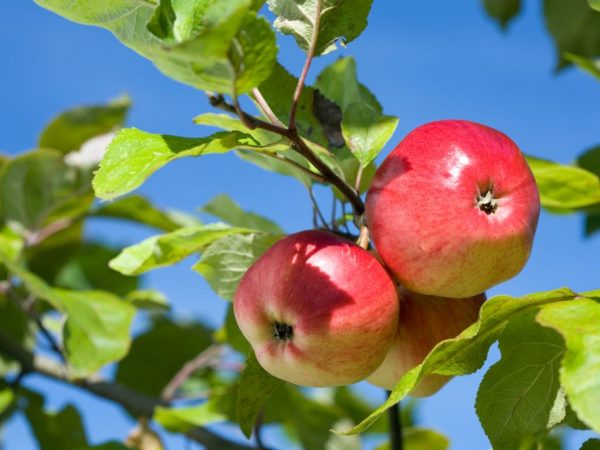Popular types of sweet apple varieties
Sweet apples are popular with many people. They become sweet because of monosaccharides and disaccharides, which are at least 10-14% in fruits. Apples are rich in vitamins A, C and group B, contain calcium, iron and other nutrients.

Popular types of sweet apple varieties
Summer varieties
Summer apples are an inexhaustible storehouse of vitamins and minerals. Among the advantages of such apple trees, it is worth highlighting an early harvest, fresh fruit taste and low calorie content. This is because they have lower sugar levels in the middle of summer and higher ones in winter.
Summer apples of sweet varieties are not intended for long-term transportation or storage. Such a crop can hardly be preserved for 2 weeks, so it is best to pick them immediately before use. The collection period is the second half of the summer.
The top 8 summer sweet species are distinguished:
- White filling. It is famous for its large green fruits, which weigh up to 150 g. The peel is specific, it becomes almost transparent. The apples themselves are round, narrowed upwards;
- Papirovka - popularly known as the Alabastrian apple tree. It enters the fruiting period very early, the first apples can be harvested in the 6th year after planting. They are greenish-white, with a pronounced taste and aroma;
- Vikich is a late-ripening summer variety. The main advantage is excellent storage. Ideal for lovers of yellow apples with a strong and pronounced aroma. The weight of the fruit is 70-90 g. The crown of the tree does not grow, it is columnar;
- Early summer was bred by breeders in Belarus. An interesting fact is that the tree is dwarf and its crown does not exceed 0.5 m in diameter, but this does not prevent gardeners from collecting 50-70 kg of harvest per season. The apples are sweet, light yellow without dots. The pulp is loose, creamy or beige, without sourness. Fruit weight - only 50 g;
- The dream is the most coveted apple tree of many generations of summer residents. Differs in resistance to frost and pests of various kinds, but requires careful care of the crown, which is not attractive. The maximum weight of fruits on miniature branches reaches 200 g. Color - green, yellowish-green;
- Candy is a relatively new species that has proven itself well even in the northern regions. The only drawback is a strong scab infestation, but with proper care, more than 100 kg of yellow-brown large fruits with a slightly ribbed surface can be collected from one tree;
- Memory of Lavrik. The variety was bred by P.I. Lavrik. He became the owner of apples of unprecedented sizes - 200-300 g. Sweet and sour taste and pale yellow rind are integral characteristics of everyone's favorite delicacy;
- Berdskoe is a completely new apple on the territory of Russia. Has a pronounced sourness.
Autumn varieties
Apples harvested in autumn can be stored for a very long time, but they are vulnerable for transportation. They are more tender and juicy than their July "congeners". When choosing apples, you should rely on the peel, it should be smooth, damage and disease are a clear sign of a bad fruit. It is worth noting in the description that sweet apples of autumn varieties:
- help to increase immunity;
- tone muscles and skin;
- have a beneficial effect on the cardiovascular system;
- they are advised to use in case of diabetes mellitus, overweight and weight loss. they perfectly satisfy the feeling of hunger and saturate the body for a long time due to the high content of carbohydrates.
Characteristic
Giving preference to sweet varieties of apples, it is worth considering their ripening period, resistance to pests and diseases, the possibility of transportation, if necessary.

Autumn varieties of apples are distinguished by the possibility of long-term storage.
Autumn varieties of sweet apples:
- Lobo. The apples are yellow or green-yellow in color with incredibly tasty pulp. The time of collection is mid-September, at which time the peel acquires a beautiful burgundy tint;
- Lambar is a favorite of gardeners. It resembles honey, fruits can be stored in boxes until late winter, and its aroma is comparable to the herb of the same name;
- Michurinsky (Michurinets). A wonderful autumn view of pink apples, which is not inferior in popularity to White filling and Golden. The size is large - 150 g, the fruits are very juicy, with sourness;
- Scarlet sweetness. Ideal for central Russia. Small apples have a balanced sweet and sour taste;
- People's. Fully lives up to its name. The tree is not very tall in structure, columnar, and its yield retains its properties well after long storage;
- Delight. The apples are burgundy or deep amber. The sweet-sweet taste has found its connoisseurs. The weight does not exceed 80 g, and the total yield per season is 45 kg. Apples do not require special storage conditions;
- Spartacus. The most common species in central Russia. The apples are big, but they don't claim to be giants. The greenish-yellow rind hides the granular white flesh beneath. Trees of the variety begin to bear fruit 5 years after planting;
- Seman. Columnar apple tree with small apples. Their weight does not exceed 50 g. Trees are susceptible to various diseases, except for scab. They are picky about storage if it does not take a long period of time;
- Welsey. Sweet and sour giant, which takes root best in central Russia, because there are ideal conditions for its cultivation. More than 5 kg can be harvested from one branch.
Winter varieties
The attention of a sweet tooth will be attracted by winter apples, because during their long ripening, they have time to accumulate a lot of sugar under the skin. They are preferred by entrepreneurs who deliver products to other cities. Winter apples of sweet varieties should be picked and carefully stacked long before they ripen, so they will retain their presentation and taste longer.
The best winter varieties are popular for their long shelf life. These include:
- Jonathan is an apple tree whose fruits have a high glycemic index, its sweets will envy even the most delicious summer and autumn species. The peel of this record holder is yellow, it is abundantly covered with a dotted red blush;
- Orlik. This species has a specific feature: the fruits are unsweetened and even fresh in summer, but after ripening they acquire a pronounced aroma and sweet and sour taste, in which they have no equal;
- Antonovka is a taste familiar from childhood. The juicy yellow fruit came to us from the Soviet past and is fundamentally entrenched in the gardens. Up to 400 kg of large apples can be harvested from one small tree. They are good for preparing various sweets, they can be stored until mid-spring and longer;
- Semerenko is a fruit with a green skin dominated by white dots. Productivity - 5-30 kg per season. Begins to bear fruit after 5 years after planting the seedling;
- In memory of Michurin - a variety that distinguished itself by its picky about watering, easily tolerates drought and disease. Its fruits are pink-white, up to 10-15 cm in diameter, but there are also small specimens (5 cm);
- The February apple got its name not because of the late harvest in February, but because even at the end of winter it looks fresh, as if it had just been picked. The white color of the flesh and the grainy texture emphasize the sweet aftertaste. The only drawback is the slightly bitter taste of the peel, which is explained by the waxy bloom on its surface;
- Belarusian winter - apple tree, bred in 2000. The green-yellow fruits are densely covered with a pink blush, on which dark stripes are present. Another feature is resistance to low temperatures and diseases. After ripening, the apples remain firmly attached to the stems and do not crumble. They can be stored for a long time without loss of quality and bitter-sour smell. By pre-packing products, it can be transported over long distances.
Selection features
The seasonality of the product determines the benefits of the product, this is the only way you can get the maximum effect after use. You should not choose only one apple variety to plant in Russia.
Plan the planting of apple trees wisely: opt for early sweet varieties to delight yourself with delicious fruits as soon as possible after planting, and late ones for consumption in winter.

